Romanian vs Delaware Community Comparison
COMPARE
Romanian
Delaware
Social Comparison
Social Comparison
Romanians
Delaware
9,022
SOCIAL INDEX
87.7/ 100
SOCIAL RATING
35th/ 347
SOCIAL RANK
3,204
SOCIAL INDEX
29.6/ 100
SOCIAL RATING
228th/ 347
SOCIAL RANK
Delaware Integration in Romanian Communities
The statistical analysis conducted on geographies consisting of 86,367,341 people shows a mild positive correlation between the proportion of Delaware within Romanian communities in the United States with a correlation coefficient (R) of 0.378. On average, for every 1% (one percent) increase in Romanians within a typical geography, there is an increase of 0.335% in Delaware. To illustrate, in a geography comprising of 100,000 individuals, a rise of 1,000 Romanians corresponds to an increase of 335.1 Delaware.
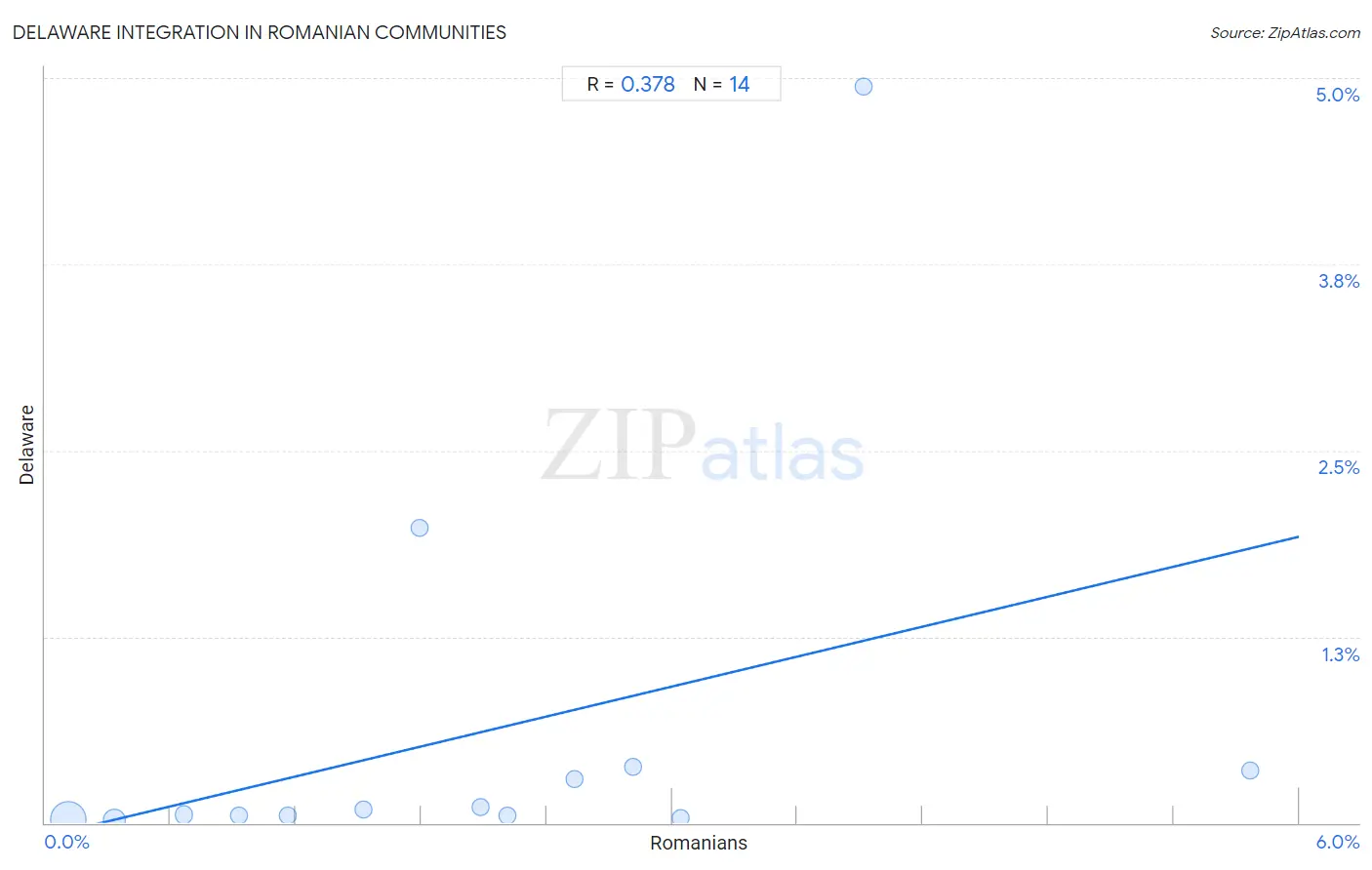
Romanian vs Delaware Income
When considering income, the most significant differences between Romanian and Delaware communities in the United States are seen in per capita income ($48,445 compared to $40,778, a difference of 18.8%), median family income ($111,243 compared to $96,958, a difference of 14.7%), and median male earnings ($60,063 compared to $52,412, a difference of 14.6%). Conversely, both communities are more comparable in terms of wage/income gap (28.0% compared to 26.3%, a difference of 6.2%), median female earnings ($41,663 compared to $37,964, a difference of 9.7%), and householder income over 65 years ($64,142 compared to $58,214, a difference of 10.2%).

| Income Metric | Romanian | Delaware |
| Per Capita Income | Exceptional $48,445 | Tragic $40,778 |
| Median Family Income | Exceptional $111,243 | Tragic $96,958 |
| Median Household Income | Exceptional $91,994 | Tragic $80,527 |
| Median Earnings | Exceptional $50,244 | Tragic $44,783 |
| Median Male Earnings | Exceptional $60,063 | Poor $52,412 |
| Median Female Earnings | Exceptional $41,663 | Tragic $37,964 |
| Householder Age | Under 25 years | Exceptional $53,632 | Tragic $47,159 |
| Householder Age | 25 - 44 years | Exceptional $102,544 | Tragic $89,876 |
| Householder Age | 45 - 64 years | Exceptional $108,609 | Tragic $94,914 |
| Householder Age | Over 65 years | Exceptional $64,142 | Tragic $58,214 |
| Wage/Income Gap | Tragic 28.0% | Fair 26.3% |
Romanian vs Delaware Poverty
When considering poverty, the most significant differences between Romanian and Delaware communities in the United States are seen in single male poverty (12.5% compared to 15.0%, a difference of 20.3%), child poverty under the age of 5 (16.0% compared to 18.7%, a difference of 17.2%), and receiving food stamps (10.4% compared to 12.2%, a difference of 16.4%). Conversely, both communities are more comparable in terms of seniors poverty over the age of 75 (11.6% compared to 11.4%, a difference of 1.5%), seniors poverty over the age of 65 (10.1% compared to 10.2%, a difference of 1.7%), and married-couple family poverty (4.8% compared to 5.1%, a difference of 4.7%).
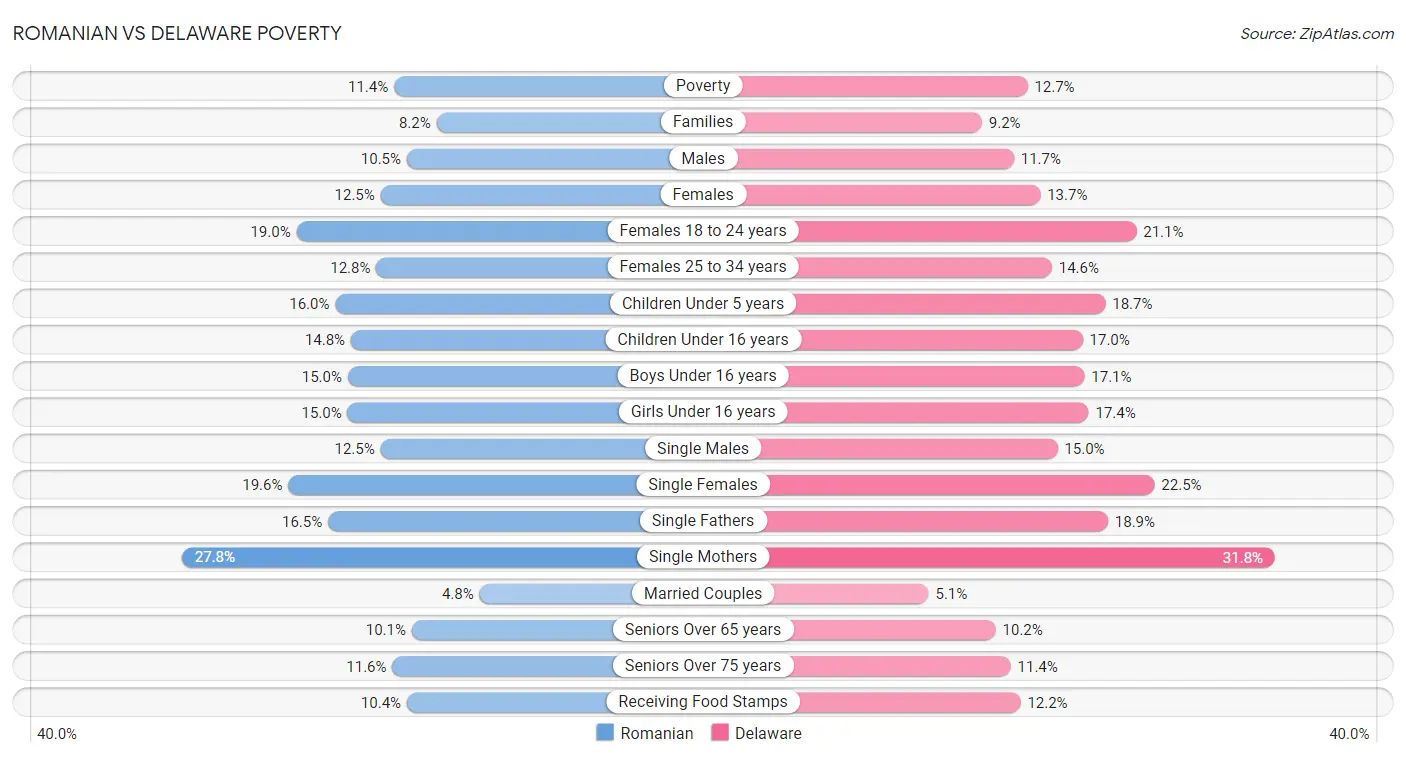
| Poverty Metric | Romanian | Delaware |
| Poverty | Exceptional 11.4% | Fair 12.7% |
| Families | Exceptional 8.2% | Fair 9.2% |
| Males | Exceptional 10.5% | Poor 11.7% |
| Females | Exceptional 12.5% | Fair 13.7% |
| Females 18 to 24 years | Exceptional 19.0% | Tragic 21.1% |
| Females 25 to 34 years | Exceptional 12.8% | Tragic 14.6% |
| Children Under 5 years | Exceptional 16.0% | Tragic 18.7% |
| Children Under 16 years | Exceptional 14.8% | Poor 17.0% |
| Boys Under 16 years | Exceptional 15.0% | Poor 17.1% |
| Girls Under 16 years | Exceptional 15.0% | Poor 17.4% |
| Single Males | Excellent 12.5% | Tragic 15.0% |
| Single Females | Exceptional 19.6% | Tragic 22.5% |
| Single Fathers | Fair 16.5% | Tragic 18.9% |
| Single Mothers | Exceptional 27.8% | Tragic 31.8% |
| Married Couples | Exceptional 4.8% | Good 5.1% |
| Seniors Over 65 years | Exceptional 10.1% | Exceptional 10.2% |
| Seniors Over 75 years | Exceptional 11.6% | Exceptional 11.4% |
| Receiving Food Stamps | Exceptional 10.4% | Fair 12.2% |
Romanian vs Delaware Unemployment
When considering unemployment, the most significant differences between Romanian and Delaware communities in the United States are seen in unemployment among women with children under 6 years (7.2% compared to 9.8%, a difference of 36.5%), unemployment among ages 30 to 34 years (5.3% compared to 6.7%, a difference of 25.2%), and unemployment among women with children ages 6 to 17 years (8.6% compared to 10.5%, a difference of 22.1%). Conversely, both communities are more comparable in terms of unemployment among ages 55 to 59 years (4.7% compared to 4.7%, a difference of 0.060%), unemployment among seniors over 75 years (9.0% compared to 9.0%, a difference of 0.080%), and unemployment among ages 60 to 64 years (4.7% compared to 5.0%, a difference of 6.8%).
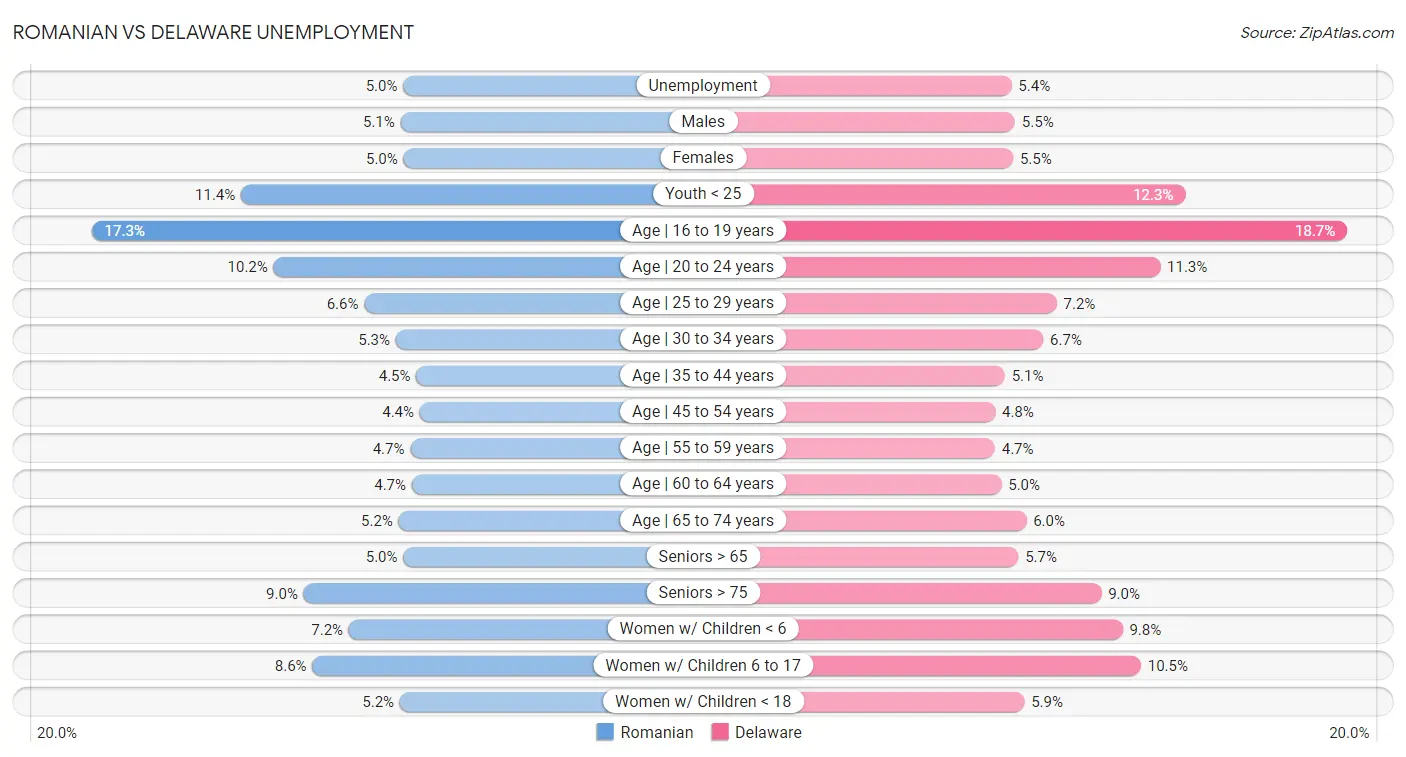
| Unemployment Metric | Romanian | Delaware |
| Unemployment | Exceptional 5.0% | Poor 5.4% |
| Males | Excellent 5.1% | Tragic 5.5% |
| Females | Exceptional 5.0% | Tragic 5.5% |
| Youth < 25 | Excellent 11.4% | Tragic 12.3% |
| Age | 16 to 19 years | Good 17.3% | Tragic 18.7% |
| Age | 20 to 24 years | Excellent 10.2% | Tragic 11.3% |
| Age | 25 to 29 years | Good 6.6% | Tragic 7.2% |
| Age | 30 to 34 years | Excellent 5.3% | Tragic 6.7% |
| Age | 35 to 44 years | Exceptional 4.5% | Tragic 5.1% |
| Age | 45 to 54 years | Exceptional 4.4% | Tragic 4.8% |
| Age | 55 to 59 years | Excellent 4.7% | Excellent 4.7% |
| Age | 60 to 64 years | Exceptional 4.7% | Tragic 5.0% |
| Age | 65 to 74 years | Exceptional 5.2% | Tragic 6.0% |
| Seniors > 65 | Exceptional 5.0% | Tragic 5.7% |
| Seniors > 75 | Poor 9.0% | Poor 9.0% |
| Women w/ Children < 6 | Exceptional 7.2% | Tragic 9.8% |
| Women w/ Children 6 to 17 | Exceptional 8.6% | Tragic 10.5% |
| Women w/ Children < 18 | Exceptional 5.2% | Tragic 5.9% |
Romanian vs Delaware Labor Participation
When considering labor participation, the most significant differences between Romanian and Delaware communities in the United States are seen in in labor force | age 16-19 (37.5% compared to 38.6%, a difference of 3.1%), in labor force | age 45-54 (83.0% compared to 80.8%, a difference of 2.7%), and in labor force | age 20-64 (79.8% compared to 77.8%, a difference of 2.5%). Conversely, both communities are more comparable in terms of in labor force | age 20-24 (75.5% compared to 75.5%, a difference of 0.010%), in labor force | age 25-29 (84.8% compared to 83.7%, a difference of 1.4%), and in labor force | age 35-44 (84.5% compared to 83.2%, a difference of 1.6%).

| Labor Participation Metric | Romanian | Delaware |
| In Labor Force | Age > 16 | Fair 65.0% | Tragic 63.6% |
| In Labor Force | Age 20-64 | Good 79.8% | Tragic 77.8% |
| In Labor Force | Age 16-19 | Excellent 37.5% | Exceptional 38.6% |
| In Labor Force | Age 20-24 | Excellent 75.5% | Excellent 75.5% |
| In Labor Force | Age 25-29 | Good 84.8% | Tragic 83.7% |
| In Labor Force | Age 30-34 | Good 84.8% | Tragic 83.5% |
| In Labor Force | Age 35-44 | Good 84.5% | Tragic 83.2% |
| In Labor Force | Age 45-54 | Good 83.0% | Tragic 80.8% |
Romanian vs Delaware Family Structure
When considering family structure, the most significant differences between Romanian and Delaware communities in the United States are seen in births to unmarried women (28.7% compared to 34.2%, a difference of 18.9%), single father households (2.1% compared to 2.5%, a difference of 17.6%), and single mother households (5.6% compared to 6.5%, a difference of 15.8%). Conversely, both communities are more comparable in terms of family households (64.5% compared to 64.6%, a difference of 0.020%), average family size (3.18 compared to 3.20, a difference of 0.54%), and family households with children (27.6% compared to 27.4%, a difference of 0.66%).

| Family Structure Metric | Romanian | Delaware |
| Family Households | Good 64.5% | Good 64.6% |
| Family Households with Children | Good 27.6% | Average 27.4% |
| Married-couple Households | Exceptional 48.4% | Good 46.8% |
| Average Family Size | Tragic 3.18 | Poor 3.20 |
| Single Father Households | Exceptional 2.1% | Tragic 2.5% |
| Single Mother Households | Exceptional 5.6% | Fair 6.5% |
| Currently Married | Exceptional 48.4% | Good 46.9% |
| Divorced or Separated | Exceptional 11.8% | Tragic 12.7% |
| Births to Unmarried Women | Exceptional 28.7% | Tragic 34.2% |
Romanian vs Delaware Vehicle Availability
When considering vehicle availability, the most significant differences between Romanian and Delaware communities in the United States are seen in no vehicles in household (10.9% compared to 9.2%, a difference of 19.5%), 4 or more vehicles in household (6.2% compared to 7.2%, a difference of 16.6%), and 3 or more vehicles in household (19.3% compared to 21.5%, a difference of 11.3%). Conversely, both communities are more comparable in terms of 1 or more vehicles in household (89.2% compared to 91.0%, a difference of 2.0%), 2 or more vehicles in household (55.5% compared to 58.2%, a difference of 4.9%), and 3 or more vehicles in household (19.3% compared to 21.5%, a difference of 11.3%).

| Vehicle Availability Metric | Romanian | Delaware |
| No Vehicles Available | Poor 10.9% | Exceptional 9.2% |
| 1+ Vehicles Available | Poor 89.2% | Exceptional 91.0% |
| 2+ Vehicles Available | Average 55.5% | Exceptional 58.2% |
| 3+ Vehicles Available | Fair 19.3% | Exceptional 21.5% |
| 4+ Vehicles Available | Fair 6.2% | Exceptional 7.2% |
Romanian vs Delaware Education Level
When considering education level, the most significant differences between Romanian and Delaware communities in the United States are seen in professional degree (5.3% compared to 3.6%, a difference of 45.8%), doctorate degree (2.1% compared to 1.6%, a difference of 33.9%), and master's degree (17.2% compared to 13.0%, a difference of 32.2%). Conversely, both communities are more comparable in terms of 8th grade (96.5% compared to 96.5%, a difference of 0.0%), 5th grade (97.8% compared to 97.8%, a difference of 0.010%), and 4th grade (97.9% compared to 97.9%, a difference of 0.020%).
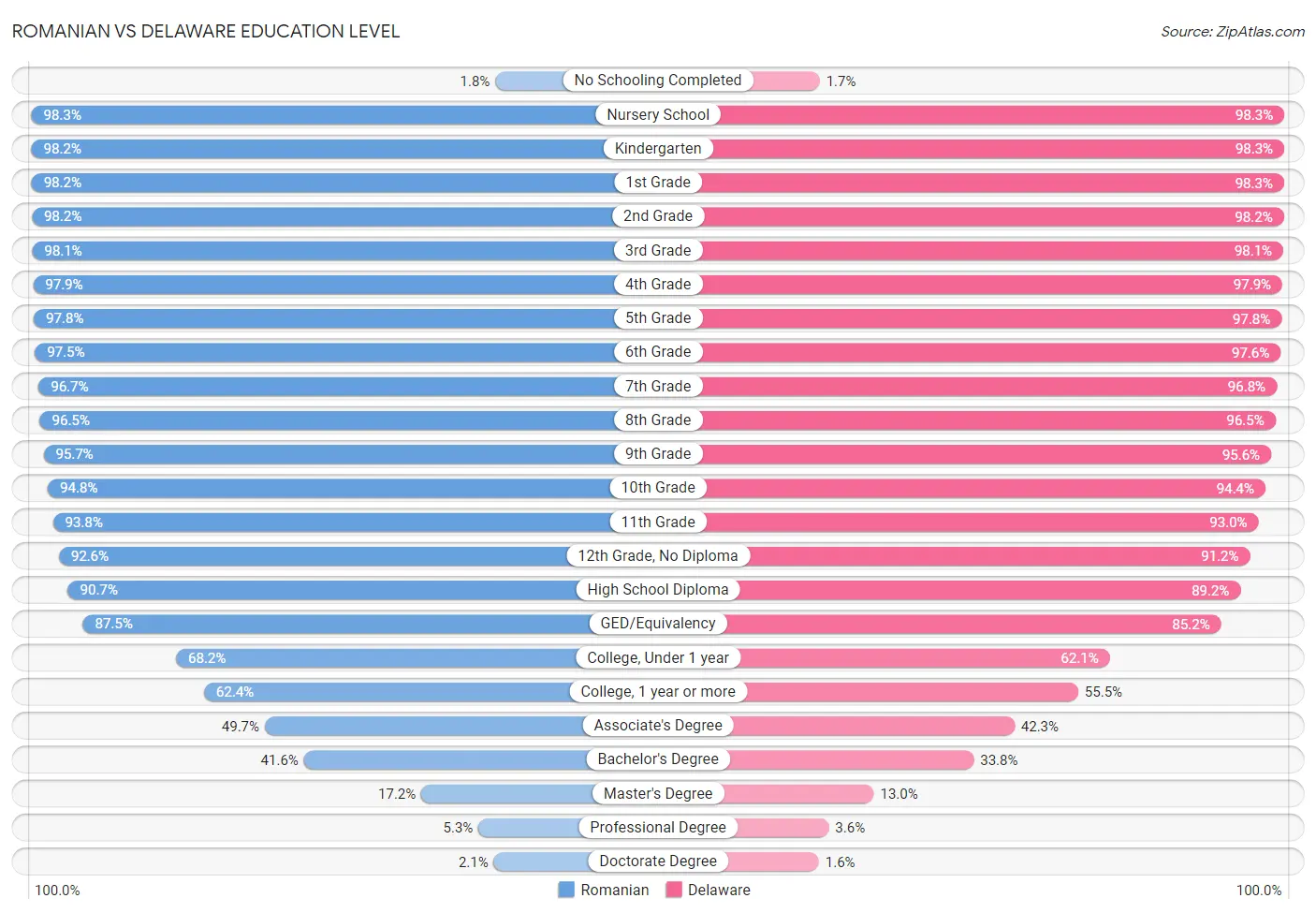
| Education Level Metric | Romanian | Delaware |
| No Schooling Completed | Exceptional 1.8% | Exceptional 1.7% |
| Nursery School | Exceptional 98.3% | Exceptional 98.3% |
| Kindergarten | Exceptional 98.2% | Exceptional 98.3% |
| 1st Grade | Exceptional 98.2% | Exceptional 98.3% |
| 2nd Grade | Exceptional 98.2% | Exceptional 98.2% |
| 3rd Grade | Exceptional 98.1% | Exceptional 98.1% |
| 4th Grade | Exceptional 97.9% | Exceptional 97.9% |
| 5th Grade | Exceptional 97.8% | Exceptional 97.8% |
| 6th Grade | Exceptional 97.5% | Exceptional 97.6% |
| 7th Grade | Exceptional 96.7% | Exceptional 96.8% |
| 8th Grade | Exceptional 96.5% | Exceptional 96.5% |
| 9th Grade | Exceptional 95.7% | Exceptional 95.6% |
| 10th Grade | Exceptional 94.8% | Exceptional 94.4% |
| 11th Grade | Exceptional 93.8% | Excellent 93.0% |
| 12th Grade, No Diploma | Exceptional 92.6% | Average 91.2% |
| High School Diploma | Exceptional 90.7% | Average 89.2% |
| GED/Equivalency | Exceptional 87.5% | Fair 85.2% |
| College, Under 1 year | Exceptional 68.2% | Tragic 62.1% |
| College, 1 year or more | Exceptional 62.4% | Tragic 55.5% |
| Associate's Degree | Exceptional 49.7% | Tragic 42.3% |
| Bachelor's Degree | Exceptional 41.6% | Tragic 33.8% |
| Master's Degree | Exceptional 17.2% | Tragic 13.0% |
| Professional Degree | Exceptional 5.3% | Tragic 3.6% |
| Doctorate Degree | Exceptional 2.1% | Tragic 1.6% |
Romanian vs Delaware Disability
When considering disability, the most significant differences between Romanian and Delaware communities in the United States are seen in disability age 35 to 64 (10.6% compared to 13.7%, a difference of 28.9%), disability age 18 to 34 (6.6% compared to 8.2%, a difference of 23.8%), and vision disability (2.1% compared to 2.5%, a difference of 21.8%). Conversely, both communities are more comparable in terms of disability age over 75 (46.2% compared to 47.5%, a difference of 2.7%), cognitive disability (16.6% compared to 17.4%, a difference of 5.0%), and self-care disability (2.4% compared to 2.7%, a difference of 10.8%).
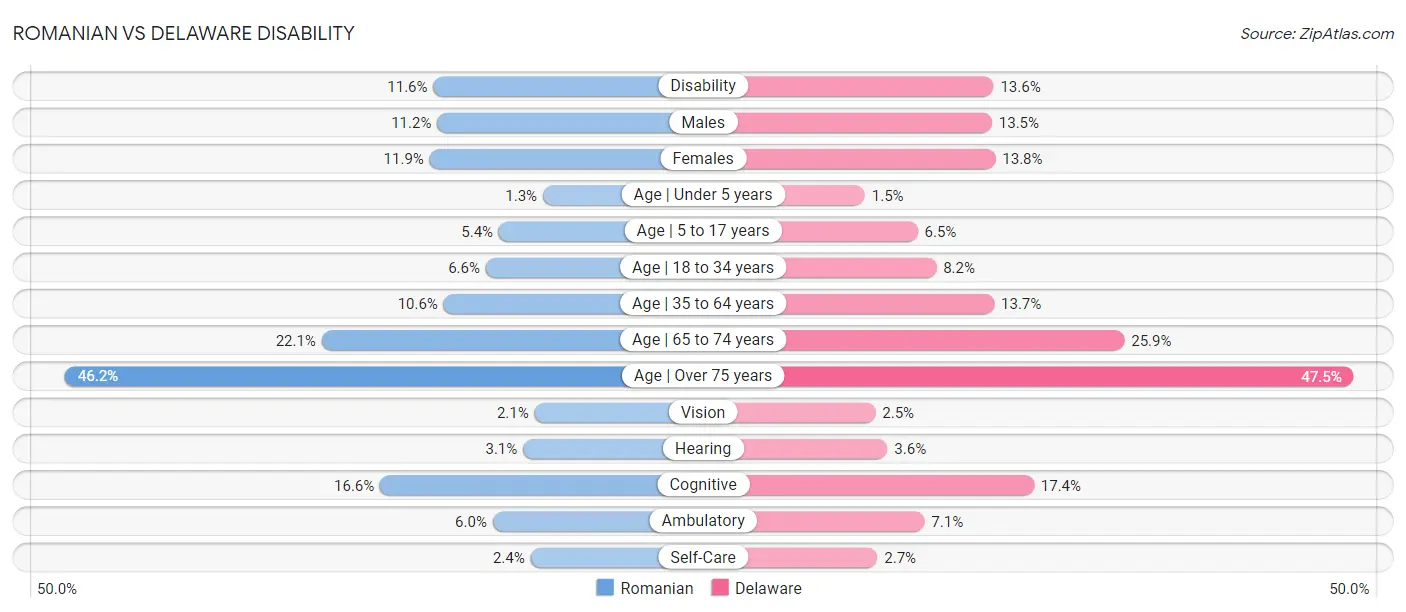
| Disability Metric | Romanian | Delaware |
| Disability | Good 11.6% | Tragic 13.6% |
| Males | Average 11.2% | Tragic 13.5% |
| Females | Exceptional 11.9% | Tragic 13.8% |
| Age | Under 5 years | Fair 1.3% | Tragic 1.5% |
| Age | 5 to 17 years | Exceptional 5.4% | Tragic 6.5% |
| Age | 18 to 34 years | Fair 6.6% | Tragic 8.2% |
| Age | 35 to 64 years | Exceptional 10.6% | Tragic 13.7% |
| Age | 65 to 74 years | Exceptional 22.1% | Tragic 25.9% |
| Age | Over 75 years | Exceptional 46.2% | Fair 47.5% |
| Vision | Exceptional 2.1% | Tragic 2.5% |
| Hearing | Poor 3.1% | Tragic 3.6% |
| Cognitive | Exceptional 16.6% | Fair 17.4% |
| Ambulatory | Excellent 6.0% | Tragic 7.1% |
| Self-Care | Good 2.4% | Tragic 2.7% |